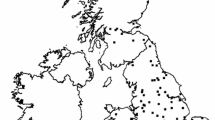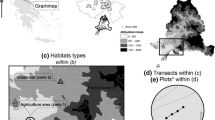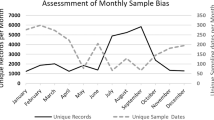Abstract
Species richness and evenness, the two principle components of species diversity, are frequently used to describe variation in species assemblages in space and time. Compound indices, including variations of both the Shannon–Wiener index and Simpson’s index, are assumed to intelligibly integrate species richness and evenness into all-encompassing measures. However, the efficacy of compound indices is disputed by the possibility of inverse relationships between species richness and evenness. Past studies have assessed relationships between various diversity measures across survey locations for a variety of taxa, often finding species richness and evenness to be inversely related. Butterflies are one of the most intensively monitored taxa worldwide, but have been largely neglected in such studies. Long-term butterfly monitoring programs provide a unique opportunity for analyzing how trends in species diversity relate to habitat and environmental conditions. However, analyzing trends in butterfly diversity first requires an assessment of the applicability of common diversity measures to butterfly assemblages. To accomplish this, we quantified relationships between butterfly diversity measures estimated from 10 years of butterfly population data collected in the North Saskatchewan River Valley in Edmonton, Alberta, Canada. Species richness and evenness were inversely related within the butterfly assemblage. We conclude that species evenness may be used in conjunction with richness to deepen our understandings of assemblage organization, but combining these two components within compound indices does not produce measures that consistently align with our intuitive sense of species diversity.

Similar content being viewed by others
References
Andelman SJ, Willig MR (2003) Present patterns and future prospects for biodiversity in the Western Hemisphere. Ecol Lett 6(9):818–824. doi:10.1046/j.1461-0248.2003.00503.x
Bock CE, Jones ZF, Bock JH (2007) Relationships between species richness, evenness, and abundance in a southwestern savanna. Ecology 88(5):1322–1327. doi:10.1890/06-0654
Buzas MA, Hayek LC (1996) Biodiversity resolution: an integrated approach. Biodivers Lett 4:40–43. doi:10.2307/2999767
Camargo JA (1992) Can dominance influence stability in competitive interactions. Oikos 64:605–609. doi:10.2307/3545183
Caswell H (1976) Community structure: a neutral model analysis. Ecol Monogr 46(3):327–354. doi:10.2307/1942257
Chao A, Gotelli NJ, Hsieh T et al (2014) Rarefaction and extrapolation with Hill numbers: a framework for sampling and estimation in species diversity studies. Ecol Monogr 84(1):45–67. doi:10.1890/13-0133.1
Fleishman E, Murphy DD (2009) A realistic assessment of the indicator potential of butterflies and other charismatic taxonomic groups. Conserv Biol 23(5):1109–1116. doi:10.1111/j.1523-1739.2009.01246.x
Gosselin F (2006) An assessment of the dependence of evenness indices on species richness. J Theor Biol 242(3):591–597. doi:10.1016/j.jtbi.2006.04.017
Hawkins BA, Porter EE (2003) Does herbivore diversity depend on plant diversity? The case of California butterflies. Am Nat 161(1):40–49. doi:10.1086/345479
Hill MO (1973) Diversity and evenness: a unifying notation and its consequences. Ecology 54(2):427–432. doi:10.2307/1934352
Humphries CJ, Williams PH, Vane-Wright RI (1995) Measuring biodiversity value for conservation. Annu Rev Ecol Syst 26:93–111. doi:10.1146/annurev.es.26.110195.000521
Hurlbert SH (1971) The nonconcept of species diversity: a critique and alternative parameters. Ecology 52(4):577–586. doi:10.2307/1934145
Izsák J, Papp L (2000) A link between ecological diversity indices and measures of biodiversity. Ecol Model 130(1):151–156. doi:10.1016/S0304-3800(00)00203-9
Jost L (2006) Entropy and diversity. Oikos 113(2):363–375. doi:10.1111/j.2006.0030-1299.14714.x
Keylock C (2005) Simpson diversity and the Shannon–Wiener index as special cases of a generalized entropy. Oikos 109(1):203–207. doi:10.1111/j.0030-1299.2005.13735.x
Kitahara M, Yumoto M, Kobayashi T (2008) Relationship of butterfly diversity with nectar plant species richness in and around the Aokigahara primary woodland of Mount Fuji, central Japan. Biodivers Conserv 17(11):2713–2734. doi:10.1007/s10531-007-9265-4
Ma M (2005) Species richness vs evenness: independent relationship and different responses to edaphic factors. Oikos 111(1):192–198. doi:10.1111/j.0030-1299.2005.13049.x
Magurran AE (2013) Measuring biological diversity. Wiley, New Jersey
Mulder C, Bazeley-White E, Dimitrakopoulos P et al (2004) Species evenness and productivity in experimental plant communities. Oikos 107(1):50–63. doi:10.1111/j.0030-1299.2004.13110.x
Nowicki P, Settele J, Henry P et al (2008) Butterfly monitoring methods: the ideal and the real world. Isr J Ecol Evol 54(1):69–88. doi:10.1560/IJEE.54.1.69
Nowicki P, Vrabec V, Binzenhöfer B et al (2014) Butterfly dispersal in inhospitable matrix: rare, risky, but long-distance. Landsc Ecol 29(3):401–412. doi:10.1007/s10980-013-9971-0
Pellet J, Bried JT, Parietti D et al (2012) Monitoring butterfly abundance: beyond Pollard walks. PLoS ONE 7(7):e41396. doi:10.1371/journal.pone.0041396
Pollard E (1977) A method for assessing changes in the abundance of butterflies. Biol Conserv 12(2):115–134. doi:10.1016/0006-3207(77)90065-9
Pollard E (1988) Temperature, rainfall and butterfly numbers. J Appl Ecol 25:819–828. doi:10.2307/2403748
Pollard E, Moss D, Yates T (1995) Population trends of common British butterflies at monitored sites. J Appl Ecol 32:9–16. doi:10.2307/2404411
Purvis A, Hector A (2000) Getting the measure of biodiversity. Nature 405:212–219. doi:10.1038/35012221
Ricotta C (2003) Parametric scaling from species relative abundances to absolute abundances in the computation of biological diversity: a first proposal using Shannon’s entropy. Acta Biotheor 51(3):181–188. doi:10.1023/A:1025142106292
Roy DB, Rothery P, Moss D et al (2001) Butterfly numbers and weather: predicting historical trends in abundance and the future effects of climate change. J Anim Ecol 70(2):201–217. doi:10.1111/j.1365-2656.2001.00480.x
Saarinen K, Lahti T, Marttila O (2003) Population trends of Finnish butterflies (Lepidoptera: Hesperioidea, Papilionoidea) in 1991–2000. Biodivers Conserv 12(10):2147–2159. doi:10.1023/A:1024189828387
Schmeller DS, HENRY P, Julliard R et al (2009) Advantages of volunteer-based biodiversity monitoring in Europe. Conserv Biol 23(2):307–316. doi:10.1111/j.1523-1739.2008.01125.x
Schmucki R, Pe’er G, Roy DB et al (2015) A regionally informed abundance index for supporting integrative analyses across butterfly monitoring schemes. J Appl Ecol 53:501–510. doi:10.1111/1365-2664.12561
Stephens PA, Pettorelli N, Barlow J et al (2015) Management by proxy? The use of indices in applied ecology. J Appl Ecol 52(1):1–6. doi:10.1111/1365-2664.12383
Stirling G, Wilsey B (2001) Empirical relationships between species richness, evenness, and proportional diversity. Am Nat 158(3):286–299. doi:10.1086/321317
Thomas JA (2005) Monitoring change in the abundance and distribution of insects using butterflies and other indicator groups. Philos Trans R Soc Lond B 360(1454):339–357. doi:10.1098/rstb.2004.1585
Tóthmérész B (1995) Comparison of different methods for diversity ordering. J Veg Sci 6(2):283–290. doi:10.2307/3236223
van Swaay C, Warren M (1999) Red data book of European butterflies (Rhopalocera). Council of Europe, Strasbourg
van Swaay C, Warren M, Loïs G (2006) Biotope use and trends of European butterflies. J Insect Conserv 10(2):189–209. doi:10.1007/s10841-006-6293-4
van Swaay C, Maes D, Collins S et al (2011) Applying IUCN criteria to invertebrates: how red is the Red List of European butterflies? Biol Conserv 144(1):470–478. doi:10.1016/j.biocon.2010.09.034
Westwood AR, Blair D (2010) Effect of regional climate warming on the phenology of butterflies in boreal forests in Manitoba Canada. Environ Entomol 39(4):1122–1133. doi:10.1603/EN09143
Wilsey BJ, Chalcraft DR, Bowles CM et al (2005) Relationships among indices suggest that richness is an incomplete surrogate for grassland biodiversity. Ecology 86(5):1178–1184. doi:10.1890/04-0394
Acknowledgements
For assistance with butterfly surveys over the years, we thank Benny Acorn, Jesse Acorn, Vanessa Block, Karen Brown, Tory Culen, Chris Fisher, Caroline LeCourtois, Christianne McDonald, Sonya Odsen, Felix Sperling, Dena Stockburger, Gagan Gill, Laura Vehring, Sarah Booth, Jennine Pedersen, and Ulrike Shlägel. All butterfly surveys were coordinated and overseen by the third author, John H. Acorn. We also extend thanks to Sonya Odsen and Federico Riva for their insights and assistance with analyses, and to Uldis Silins for his assistance in acquiring historical weather data. Finally, we acknowledge and thank both Janet Sperling and Felix Sperling for their invaluable insights and reviews of the manuscript.
Author information
Authors and Affiliations
Corresponding author
Additional information
Communicated by P. Ponel.
Rights and permissions
About this article
Cite this article
MacDonald, Z.G., Nielsen, S.E. & Acorn, J.H. Negative relationships between species richness and evenness render common diversity indices inadequate for assessing long-term trends in butterfly diversity. Biodivers Conserv 26, 617–629 (2017). https://doi.org/10.1007/s10531-016-1261-0
Received:
Revised:
Accepted:
Published:
Issue Date:
DOI: https://doi.org/10.1007/s10531-016-1261-0




